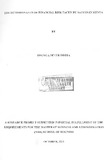| dc.description.abstract | The fact that most Saccos operate within a defined common bond exposes them to a relatively high degree of financial risks compared to corporate firms. In deed many Saccos in the world have in the past experienced some crisis in their operations and sustainability as a result of lack of risk identification and management mechanisms. Most of the relevant studies conducted have been focusing on the general risk management practices employed by Saccos and only a few have considered causes of financial risks in order to provide clear answers to the directors, management and stakeholders of these Saccos to enable them address these risks.
The general objective of this research was to establish the determinants of financial risks faced by the Saccos in Kenyan and provide strategies to mitigate against these risks. The research design employed in the study is basically exploratory. Population of the study comprises of the two hundred and eight (208) Saccos operating front office services (FOSAs) in Kenya. The sample size of thirty is drawn from representative Saccos over the country due to homogeneity of operations of the Saccos. A random sampling method was used as it provides equal chance of selecting each member of the population. The study depended on secondary data from a sample of Saccos. The data source is the audited financial statements for a period of six years. A regression analysis was applied on the parameters to determine the interrelationship among the various variables. This was an analytical study that adopted a time series or longitudinal approach, supplemented by cross-sectional comparisons. The study used data for the 10 Saccos for the period (2006-2010) which was exposed to sensitivity analysis using OLS regression. The study concludes that credit risks and liquidity risks were determinants of financial risks.
While the study found that Loan size, Sacco membership size and credit product portfolio have a significant influence on the credit risk, Credit product portfolio negatively influence the credit risks implying that the increase in number of loan products in a Sacco reduces the credit exposure of that Sacco. The study also deduced that fixed Asset Level, debt ratio/leverage and dividend influenced the liquidity risks where governance cost and
IV
Debt ratio/leverage negatively influences the liquidity risks. To manage financial risks, the study recommended that Managers of Saccos should concentrate on improving on operational efficiency by investing in good information management system that will assist in managing the larger loan size and membership since its is their desire to increase membership and loans to members. Equally, External borrowing and dividend payment should be at the right time, when the Sacco has good liquidity, to ensure liquidity risks are reduced. | en_US |

